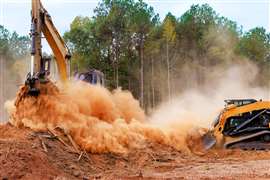Emissions agreement averts job loss fears
30 June 2016
European authorities have proposed an extension to the timetable for introducing the new Stage V engine emissions regulations and averted fears of job losses at crane manufacturers.
The European Commission said that the new regulations for engines in non-road mobile machinery will become mandatory on 1 January 2019. Under the Commission’s original proposals, all equipment manufacturers (OEMs) were given a 12 month transition period after the regulations had come into force to adapt their machines to Stage V engines, plus a six month “sell-off” period.
Now, following so-called “trilog” meetings last month involving representatives from the both the European Council and relevant European Parliament committees, all manufacturers have been granted an 18 month transition period, with mobile crane manufacturers a further 12 months on top of that. The additional 6 month “sell-off” period remains unchanged for all types of products.
The new timetable still has to be finally agreed by the European Parliament and the Council of Ministers but Brussels sources expect the changes to be ratified.
The agreement follows concerted lobbying from all sides of the mobile crane industry, led by the European Materials Handling Equipment Federation (FEM) Cranes and Lifting Equipment Product Group with the support of the European Association for Abnormal Road Transport and Mobile Cranes (ESTA).
The manufacturers argued that they need three years to implement the changes, excluding the six month sell-off period. They warned that the Commission’s plans for a transition period of only 12 months would lead to thousands of job losses while the industry adapted to the changes and that it would seriously weaken the European mobile crane manufacturing sector.
In the event they have six months less than they requested but are reasonably happy with the result. Klaus Meissner, president of FEM’s Mobile Crane Product Group and director, product strategy, at Terex Cranes, said, “It is a good compromise. It is not actually what we asked for but we will have to cope with it. “Dealing with the new regulations will not be easy and will be a burden on us, but we will find a way to work with them.”
If the European Commission had stuck to its original proposals the manufacturers said they would have to slash capacity by two-thirds while they adjusted to the new regulations – a move that would almost certainly have led to the temporary loss of thousands of jobs.
In supporting the manufacturers, ESTA called on its members to use every available avenue to influence the European Commission to think again – by contacting MEPs, EC officials, committee members and members of their own national parliaments.
The Commission’s latest proposals are contained in the Revision of Directive 97/68/EC. This sets out the details of the new, more stringent Stage V engine emission limits for engines in the power range of 130 to 560 kW.
The regulations will affect all types of construction equipment but are especially difficult for the mobile crane manufacturers to implement because of the impact of engine changes on the whole performance of a mobile crane. “It is not a like-for-like exchange,” Søren Jansen, ESTA director, explained. “The engines get bigger and heavier with additional equipment and systems. The possibility of adapting such an engine system to the needs of a specific crane model are very limited so, instead, the crane must be adapted to the required engine system.
“In other words, changing the engine system requires changes to the engine bay which in turn changes the weight and centre of gravity of the crane. So what starts with the engine bay may then involve significant changes.”
The mobile crane manufacturers also say that their position is different from that of other equipment manufacturers as they have a large number of models. Their concerns received support from an independent study commissioned by the FEM from Professor Willibald Guenthner at the Technical University in Munich.
The report said that the moving of all AT cranes products from Stage IIIb to Stage IV engines took more than four years and cost the industry €57 million (US$ 63 million). He forecast that the move to Stage V will cost a further €66 million ($ 73 million) and would take four and a half years to complete.
Klaus Meissner added, “To be clear, we are not opposed to the directive in principle, but the proposed transition scheme in its original form was simply not feasible for mobile cranes. Now we have a compromise that will be difficult to implement but which we believe we can work with.”




